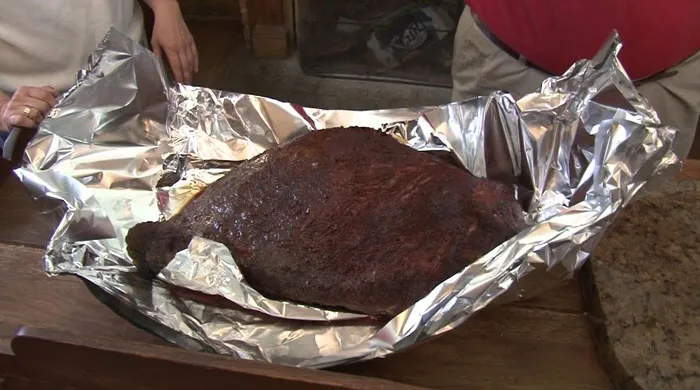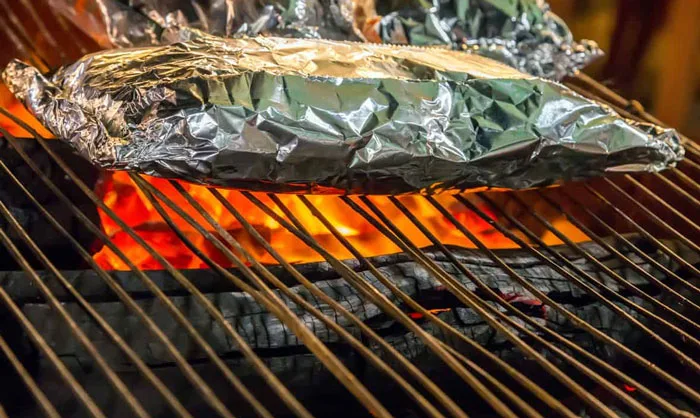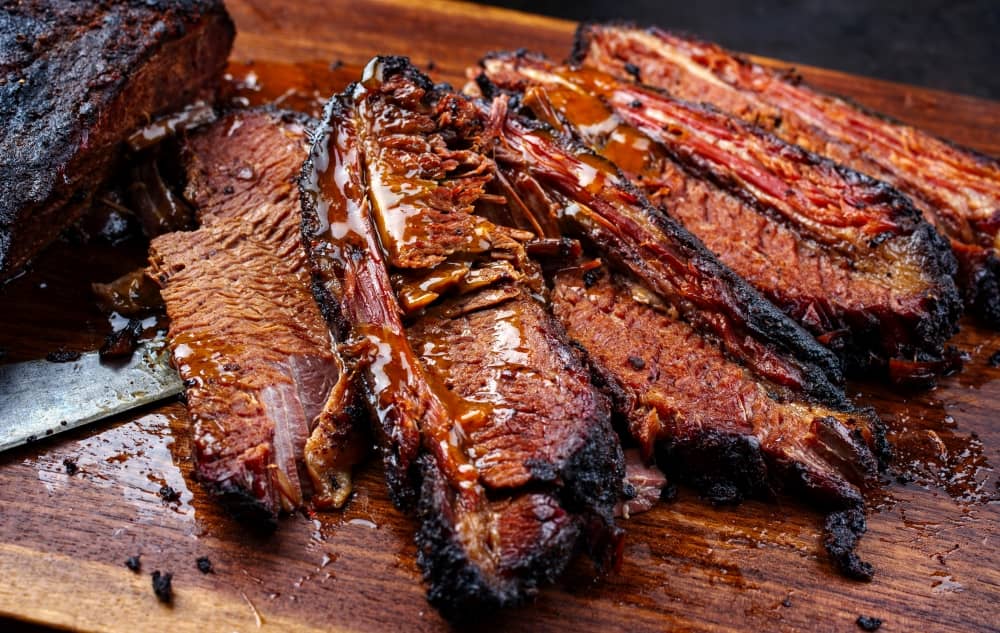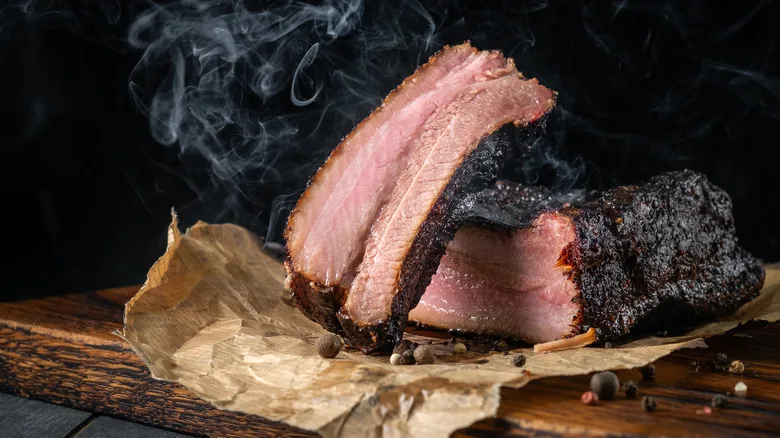Brisket is one of the most popular cuts of meat in the barbecue world. It is juicy, tender, and packed with flavor. But cooking brisket to perfection requires a lot of patience, skill, and knowledge. One of the most critical factors determining your brisket’s success is when to wrap it. Wrapping your brisket at the right time can make all the difference between a dry, challenging piece of meat and a juicy, mouthwatering one.

In this article, we’ll take a closer look at when to wrap a brisket, why it is important, and how to do it properly. We’ll also answer some common questions about brisket cooking and share tips on slicing it for maximum tenderness.
Table of Contents
Why is Brisket Wrapped?
Before we get into when to wrap a brisket, let’s first understand why we do it in the first place. Brisket is a tough cut of meat that comes from the chest of a cow. It contains a lot of connective tissue that needs to break down to become tender. This process takes time, and the longer you cook your brisket, the more tender it will become.
However, cooking a brisket for too long can also dry it out. This is where wrapping comes in. Wrapping your brisket in foil or butcher paper helps to retain moisture and prevent it from drying out. It also helps to speed up the cooking process by creating a “braising” environment inside the wrap.
What Should You Wrap Brisket With
Regarding wrapping brisket, there are two main options: foil and butcher paper. Foil is popular because it is easy to work with and provides an airtight seal. However, some pitmasters prefer butcher paper because it allows the meat to “breathe” and develop a deeper bark.
Both options have pros and cons, so it is up to personal preference. Foil is a good choice if you’re looking for a tender, moist brisket, while butcher paper is better if you want a deeper bark and a slightly drier finish.

When You Should Wrap A Brisket
Knowing when to wrap your brisket is crucial for achieving the perfect balance of tenderness and moisture. Several factors can affect when you should cover your brisket, including its size, smoker temperature, and personal preference.
Brisket Size
The size of your brisket is one of the most critical factors in determining when to wrap it. Larger briskets take longer to cook, so you may need to wrap them earlier to prevent them from drying out. As a general rule of thumb, you should wrap a brisket once it reaches the “stall” phase when the internal temperature of the meat stops rising for several hours.
Smoker Temperature
Another factor that can affect when to wrap your brisket is the temperature of your smoker. If you are cooking your brisket at a higher temperature (around 275°F), you may need to cover it earlier to prevent it from drying out. On the other hand, if you’re cooking it at a lower temperature (around 225°F), you can wait a little longer before wrapping it.
Personal Preference
Ultimately, the best time to wrap your brisket is when it has reached the level of tenderness and bark you prefer. Some pitmasters like to wrap their brisket early to keep it moist, while others prefer to let it cook longer to develop a deeper bark. It is all about finding the sweet spot that works best for you.

What Are the Risks of Wrapping a Brisket
While wrapping your brisket can help preserve moisture and prevent it from drying out, there are also some risks involved. One of the biggest risks is that wrapping can cause the bark to become soft and soggy. The bark is the flavorful crust that forms on the outside of the brisket, and it is one of the most prized parts of the meat.
If you wrap your brisket too early or for too long, the bark can become soft and lose its texture. To prevent this, some pitmasters will not wrap the brisket for the last hour or so of cooking to allow the bark to crisp up again.
Another risk of wrapping a brisket is that it can cause the meat to steam instead of smoke. This can affect the flavor of the meat and prevent the smoke from penetrating the meat fully. To prevent this, make sure to wrap the brisket tightly to prevent any steam from escaping.
When to Wrap: a Rough Time and Internal Temp
As we mentioned earlier, the best time to wrap your brisket depends on several factors. However, as a general rule of thumb, you should aim to wrap your brisket once it has reached an internal temperature of around 160-170°F. This is usually when the brisket enters the “stall” phase, and the internal temperature stops rising.
Once you wrap your brisket, you can continue cooking it until it reaches an internal temperature of around 195-205°F. This is when the connective tissue has broken down, and the brisket is fully tender.

How to Wrap a Brisket — Step-by-Step
Now that you know when to wrap your brisket, let’s take a look at how to do it properly. Here’s a step-by-step guide:
- Lay a large sheet of foil or butcher paper on a flat surface, with the shiny side facing down (if using foil).
- Place the brisket in the center of the foil/paper, fat side up.
- Fold the foil/paper over the brisket, making sure to create a tight seal around the edges.
- If using foil, crimp the edges of the foil together to create an airtight seal.
- Place the wrapped brisket back in the smoker or oven and continue cooking until it reaches the desired internal temperature.
FAQs
How to Slice a Brisket for Max Tenderness (Cut Across the Grain)
Once your brisket is cooked and rested, it’s time to slice it. To ensure maximum tenderness, it’s important to cut the meat against the grain. This means cutting perpendicular to the direction of the muscle fibers, which makes it easier to chew and prevents the meat from becoming stringy.
To do this, start by identifying the direction of the grain. The grain will run in the same direction as the long, flat side of the brisket. Then, slice the brisket into thin slices, cutting against the grain as you go.

When to Wrap Brisket Flat
If you’re cooking a brisket flat (also known as a “lean” brisket), you may need to wrap it earlier than you would a full-packer brisket. This is because the flat tends to dry out more quickly than the fattier point.
As a general rule of thumb, you should aim to wrap your brisket flat once it has reached an internal temperature of around 145-155°F. This is usually when the flat starts to dry out and the bark has set.
Wrapping the brisket flat in butcher paper is a good option as it allows for some moisture to escape, preventing the meat from becoming too moist. However, you can also use foil if you prefer a more tender and juicy finish.
